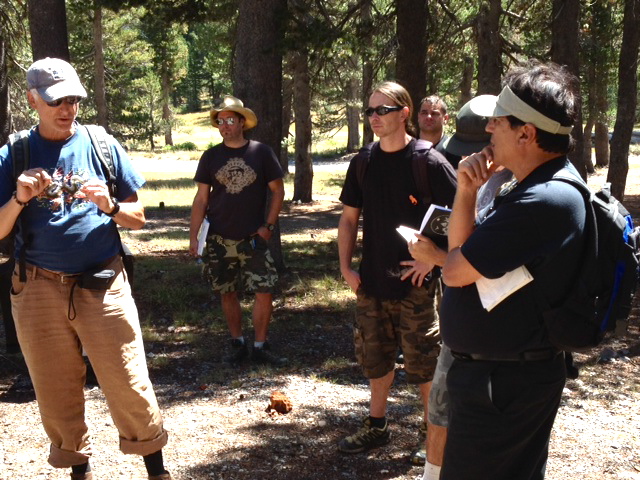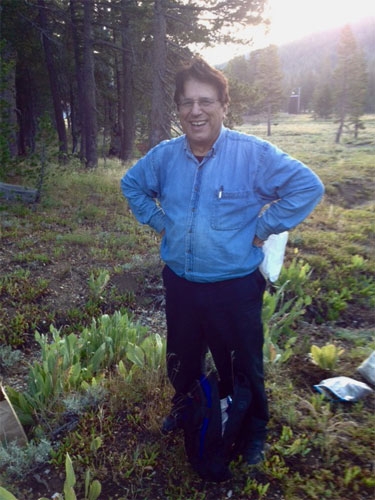Michael Tierra in the Sierra, August 2012
“I’m gathering pulsatilla which is all around me. There are also stands of mule’s ears (Wyethia species) at my feet and scattered around is California osha (Oschala), green gentian, sitka valerian, monardella (coyote mint) and arnica.”
“Michael, you want to go with us tomorrow morning to the Sierras?”
“Gee, Ben, sounds awfully tempting,” says I. “Let me check my schedule… Hey, I’m free!”
It didn’t take me long to emphatically say, “Yes, I think I would like – ah, er – no, I’m going!” Thus, with an unexpected clear August weekend, I finally acceded after 20 years’ worth of invitations from my outstanding former student (and now master) herbalist-acupuncturist Ben Zappin to join him for an herb class and wildcrafting expedition to the pristine California Sierra mountains. Two other herbalists, Darren Huckle and Brian Weissbuch, would also be there. I met up with Darren in Santa Cruz and we picked up Los Gatos herbalist and acupuncturist Abby Rappaport, stuffed our respective gear along with ourselves in Darren’s already crowded car, and rode into the sunrise to meet Ben, whose Sylvan Institute of Botanical Medicine in Berkeley sponsored the excursion.
The drive to the Mokelumne wilderness seemed to breeze by as we enthusiastically chatted and entertained ourselves to near exhaustion for the entire 5½-hour journey. In that car was a pretty high level, seminar-worthy discussion. And just think, we could look forward to even more on our return drive the following Sunday evening.
Weather temperatures hovered around 90 degrees in my Santa Cruz County mountain town of Ben Lomond, but the forecast for the Sierras was between 40 and 70 degrees and a promise of overcast skies and sudden showers. This was exactly what we got when we arrived on Friday afternoon and most of the day on Saturday.
Despite the threat of showers, we obeyed the need to stretch our legs and let the excitement of discovering what medicinal herbs were nearby pull us jauntily up the alpine slopes. The hills approaching the tree line indeed were alive with a wealth of botanical treasures. I think the others shared my feeling that it was like meeting beloved friends and relatives.
What we encountered over the span of 40 minutes was Valeriana sitchenensis (wild sitka valerian); Anemone drummondi (windflower or pulsatilla); Angelica brewerii which some compare rightly or wrongly to the properties of Chinese dang gui; Osmorhiza occidentalis (commonly known as sweet cicely), Arnica longifolia; numerous fragrant small stands of monardella (coyote mint); Ligusticum greyii (called “oschala” because it is similarly used as an upper respiratory antiviral similar to its better known Southwestern relative “osha” – Ligusticum porteri). The following day, in the same area, we found numerous distinctive specimens of Gentiana swertia (green gentian).
Then the heavens opened up. As Abby and I futilely tried to scramble back down for shelter, heavy raindrops soon turned into huge pellets from which our feeble raingear was no match. We were pretty well drenched, but probably not as much as Ben and Darren who elected to keep climbing in spite of the rain.
By nightfall we were pretty well set up with tents, sleeping bags and such, and the others slated to arrive began trickling in from around 5 pm. Personally, I thought it was a minor miracle that everyone found the spot. I guess Ben’s directions were pretty good. In any case I think he already had the money, so it was on them to find the location.
The first to arrive was the third of the three instructors, Brian Weissbuch, an herbalist, acupuncturist, wildcrafter and medicine-maker extraordinaire. I was a tag-along guest and despite my near constant teaching during the weekend I really enjoyed being a student of these three who apparently know these Sierra alpine herbs well. With Medicinal Plants of the Mountain West by the great late herbalist, Michael Moore, Jepson Manual of Vascular Plants of California and Thomas Avery Garran’s Western Herbs according to Traditional Chinese Medicine (Thomas is the co-owner along with Ben Zappin of Sylvan Institute, both former students of mine) – well, you really don’t need any other texts to seriously identify and learn some uses for the plants of the Sierras.

Brian Weissbuch(far left) and Michael Tierra (far right) with students
The next day, because of a rainy night and morning, we had a late start, around 11 am. That was when we instructors took charge and shared our knowledge, wisdom and insight with the group of about 15 students, mostly acupuncturists who liked the idea of combining their need for CEU credits for license renewal with a short wilderness adventure.
I must say that an added feature whenever Ben Zappin is in charge of an event is his spectacular cooking. He is one of the highlights of our annual week-long East West Herb School seminar that happens each spring and he showed some of his culinary magic with a spinach egg scramble and in the evening with a delicious lamb tagine. Part of Ben’s unique talent is to integrate some of the local herbs and other medicinal herbs in his cuisine. One could hardly imagine that leaves of oschala, osmorhiza or Angelica brewerii were even present in the food, but I’m assured they were and it was delicious as only a good camp-out meal can be.
Sunday we had a review of the plants we learned the day before with attendees finding the plants instead of the instructors. We also picked up some others including the potent hemostat, potentilla (probably Potentilla diversifolia better known as cinquefoil) and solidago (possibly S. californica better known as goldenrod).
Walking across the lake to a trail up a steep hill we learned some different herbs, gooseberry (Ribes roezlii), Pedicularis densiflora (Indian warrior), the poisonous, Veratrum virides and another beautiful gentian species (probably Gentiana calycosa).
These were the primary herbs we found on our two-day Sierra herbal wildcrafter herb adventure. Of course the entire event was accompanied by light-hearted banter, good food, campfire, and some medicine singing on Sunday morning. In short, the place was spectacular, the people were great and the instruction was deep and profound.
One thing the students repeatedly said they appreciated was the sharing of different ideas, experiences and knowledge about plants and healing. Somehow, rather than being confusing, most found this to be personally empowering.
Following are some highlights from the discussion of the different plants:
Gentian is a digestive used in bitters and detoxifies damp heat. The picric acid in gentian is more explosive than actual explosives! It selectively destroys viruses and bacteria. Gentian root and calamus extract with other herbs in formula is good for wasting associated with cancer.
Ligusticum greyii or oschala, along with its near relative L. porteri (osha) is antiviral and so is used for upper respiratory infections, colds, and flu. It was used effectively for prevention and treatment during the 1918 flu epidemic. It also relieves menstrual irregularity. One of us (not me) said they used it in formula for Bell’s palsy. Ligusticum species, including the local ‘oschala’ (L. greyii) is comparable in properties and use to Chinese lovage (gao ben). This and all angelicas should not be taken during pregnancy.
Angelica brewerii is regarded by some as the Western counterpart of the popular Chinese blood tonic, dang qui (Angelica sinensis). The four of us did not all agree with this assessment, finding that it was a little too bitter to serve as an alternative to Chinese dang gui. However, it definitely shares dang gui’s blood moving properties. Brian warned against the use of the more common Pacific coast Angelica hendersonii, which is toxic.
Solidago or goldenrod, along with the herb ambrosia (ragweed) are two of the most effective herbal remedies for upper respiratory allergies. Ragweed together with yerba santa as a liquid extract will stop allergy attacks within minutes and is more effective than the popular OTC drug, Claritin. Contrary to popular belief, the pollen of goldenrod does not cause allergies. Brian told the most astounding stories of using goldenrod extract (the aerial portions) to get a number of patients off of dialysis, rescuing them from certain death.
Gooseberry leaves are antiviral.
The bright chartreuse lichen called “wolf lichen” (Letharia vulpina) is a deadly poison and was used by the Achomawi natives as arrow poison. This was presented by Brian at the beginning of our trek as a warning against ingesting wild plants indiscriminately.
Not seen on the trip was a species of the common honey mushroom, Armillaria melea, sold as tian ma mi huan su, found in stretches not in the Sierras but in Marin and other specific coastal areas. Brian said this mushroom is used as a direct and ecologically sounder substitute for the endangered orchid Gastrodia elata, both having powerful antispasmodic properties.
Monardella aerial portions are used for stomach headaches probably caused by digestive problems.
Anemone, mostly the root but the aerial portions as well, is one of the most effective anti-anxiety herbs on the planet. Ben extolled at length on its virtues and one need only take two or three drops of the liquid extract to immediately feel its effects. I was particularly excited by this herb. In TCM it is used for diarrhea and dysentery and is called bai tou weng. Brian and Ben generally regard a fresh preparation of the herb to be more effective than the dried herb of most species. Supposedly dried anemone loses its anxiolytic properties.
Pedicularis or Indian warrior was not abundant where we were, but we found one live plant. This plant is one of the most powerful smooth muscle relaxants known. The average dose is 10 to 15 drops or more but one should adjust dosage according to the degree of muscle relaxation required. It was compared to kava, but unlike kava is cooling rather than heating. Its effects are nearly instant. This herb can be applied to many of the uses of medical marijuana, but without the disorienting mental state. I took about 30 drops and found myself very quiet and laid back with nothing that I wanted to say for the last couple of hours of the final herb walk.
Sitka valerian has similar sedative properties but perhaps less dulling than Valerian officinalis. Brian, who is a wealth of information on the biochemistry and uses of plants, said that the valepotriates in dried valerian are stimulant rather than sedative, which accounts for the paradoxical opposite effect of valerian on some people. I’d never heard this before. He also said that both black haw (Viburnum prunifolium) and Viburnum opulis (snowball plant or cramp bark) contain similar sedative valepotriates as valerian. Brian also described an unusual use for sitka valerian: gout.
These were only some of the highlights from what was one of the most wonderful wilderness herb classes I’ve ever attended.
The East West Herb School is going to feature at our 2013 herbal seminar (as we do each year to critical acclaim) Ben Zappin manifesting his culinary magic always with a hint of wild, medicinal herbs.
I also strongly encourage those of you who are interested to visit Sylvan Botanical Institute’s website. Don’t miss the fine classes and especially field trips they offer for herbalists, practitioners and throughout the year to the Mokelumne wilderness that borders the northern, southern and eastern parts of the California Sierra mountains. They also do similar botanical excursions earlier in the year to the dessert region of Southern California and to areas near the Big Sur mountain areas.


Gentian…I like for a sub for ginger, also blood tonic roots coming into season here in middle Tennessee. For the first time I have marked the dandelion for digging up after the first frost…….new recipes for acorns with fresh raspberry cake….RSVP